Abstract
A murine hybridoma-derived antibody (IPH.134) has been produced which has apparent high binding specificity for an extract of Schistosoma japonicum adult worms. No binding was detected to extracts of S. japonicum eggs or to extracts from other adult trematodes (Fasciola hepatica, Paragonimus westermanii, Clonorchis sinensis, and Schistosoma mansoni) and several other helminths and protozoa. When sera from two series of S. japonicum-infected Philippine patients (19 and 20 patients, respectively) were tested for inhibition of binding of 125I-labeled IPH.134 to S. japonicum adult worm antigen, a low (10%) false-negative rate was obtained. In the 19-patient series, the 4 patients with highest fecal egg counts had high inhibitory activity in their sera. In the 20-patient series, the 3 patients with prominent disease had high inhibitory activity in their sera. Evidence was obtained that IgG anti-S. japonicum antibodies (rather than circulating antigens, immune complexes, or anti-idiotypic antibodies) were most likely to be responsible for serum inhibitory activity in the test. No false-positive reactions have been obtained with pooled or individual sera from patients infected with numerous parasites other than S. japonicum, although no information is yet available on the inhibitory activities of sera fro S. mansoni- or S. hematobium-infected individuals. On the basis of the data obtained to date, it is a reasonable prediction that the molecule or determinant to which this hybridoma antibody is directed will be a useful immunodiagnostic antigen for schistosomiasis japonica in the Philippines. A test based on detection of serum antibodies to this antigen should have high specificity and may provide additional information on the level of infection or disease status in patients.
Full text
PDF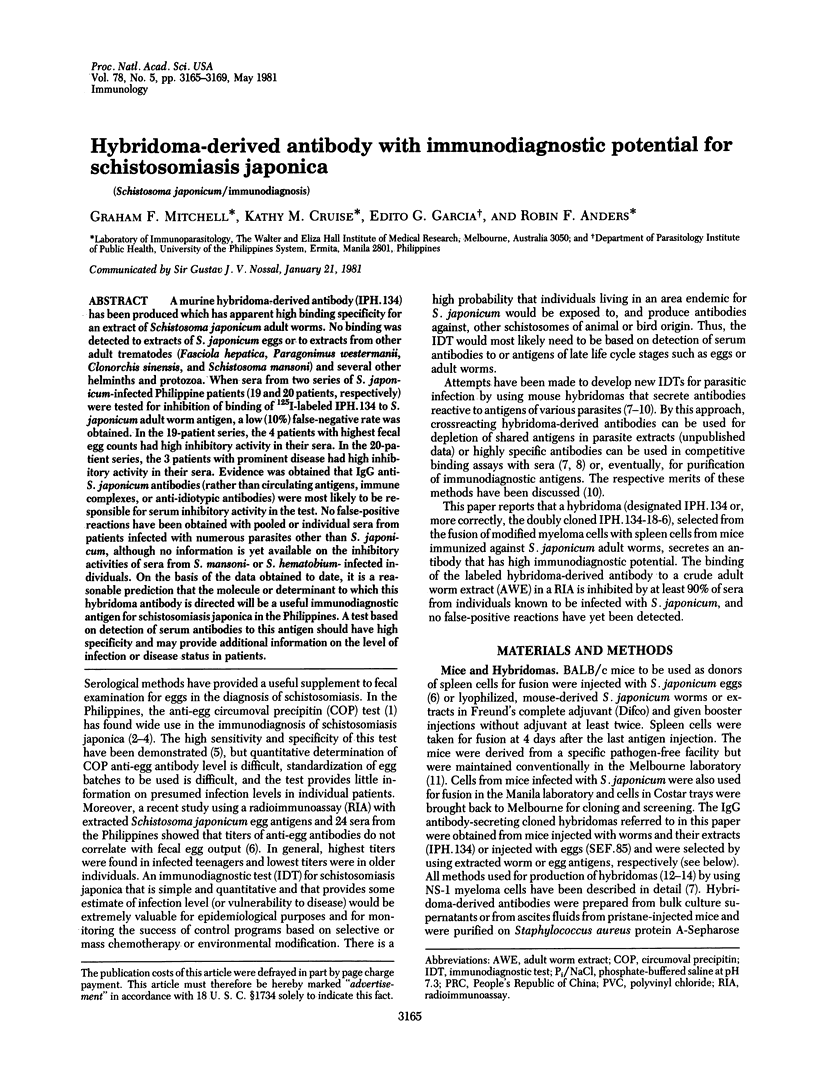
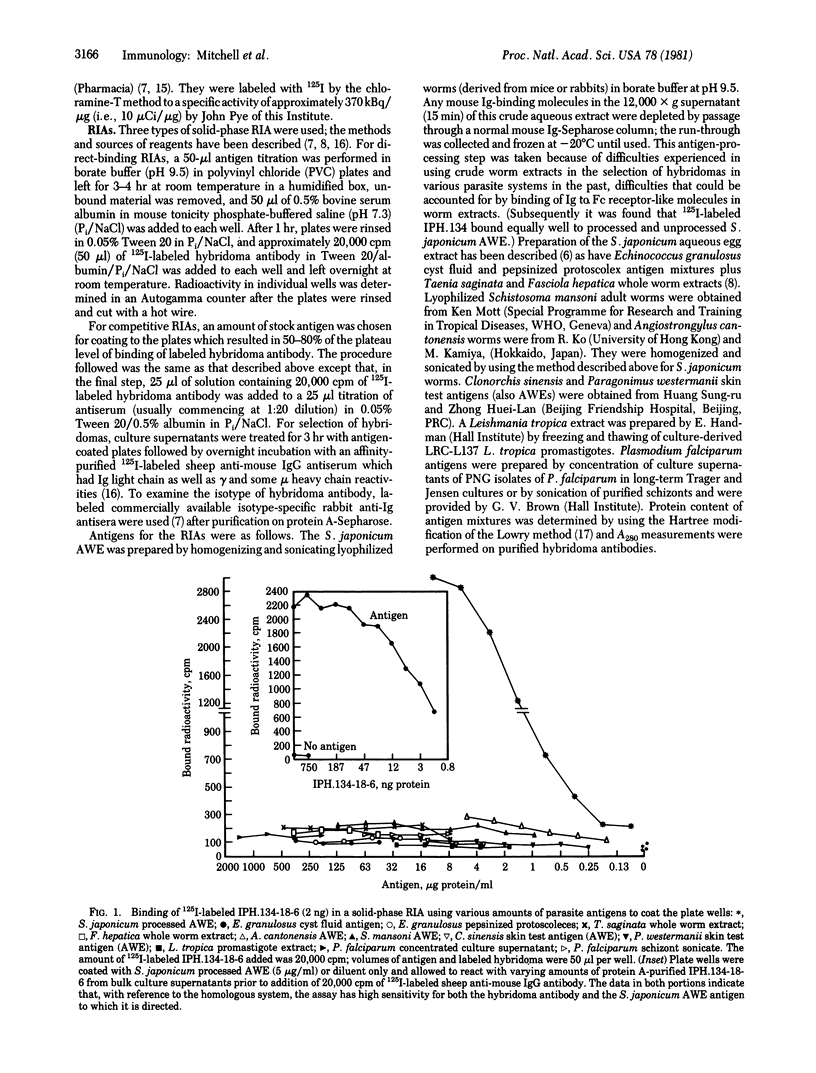
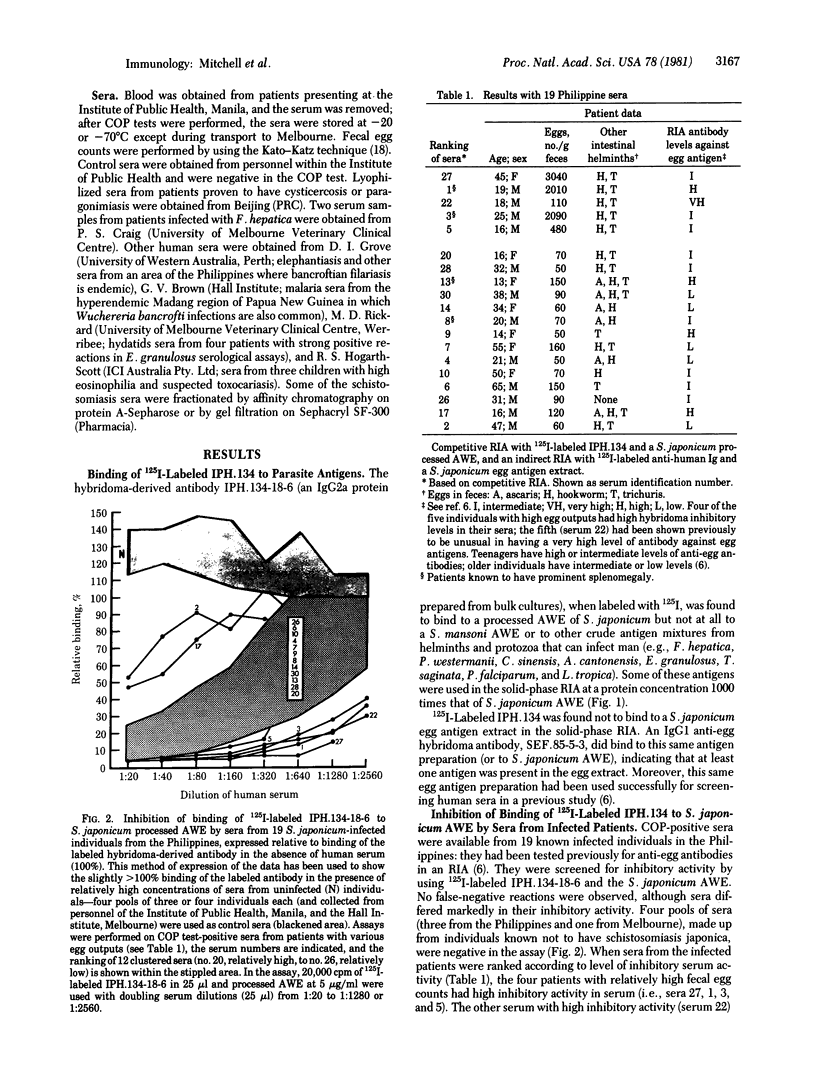
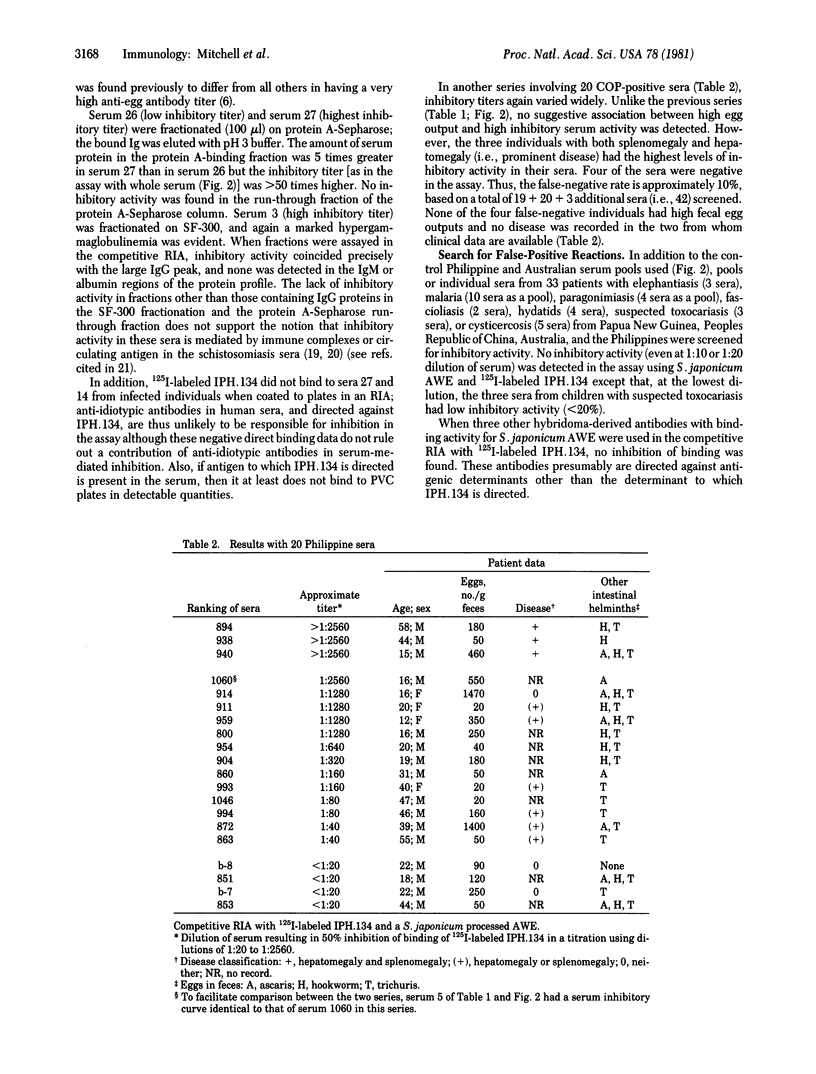
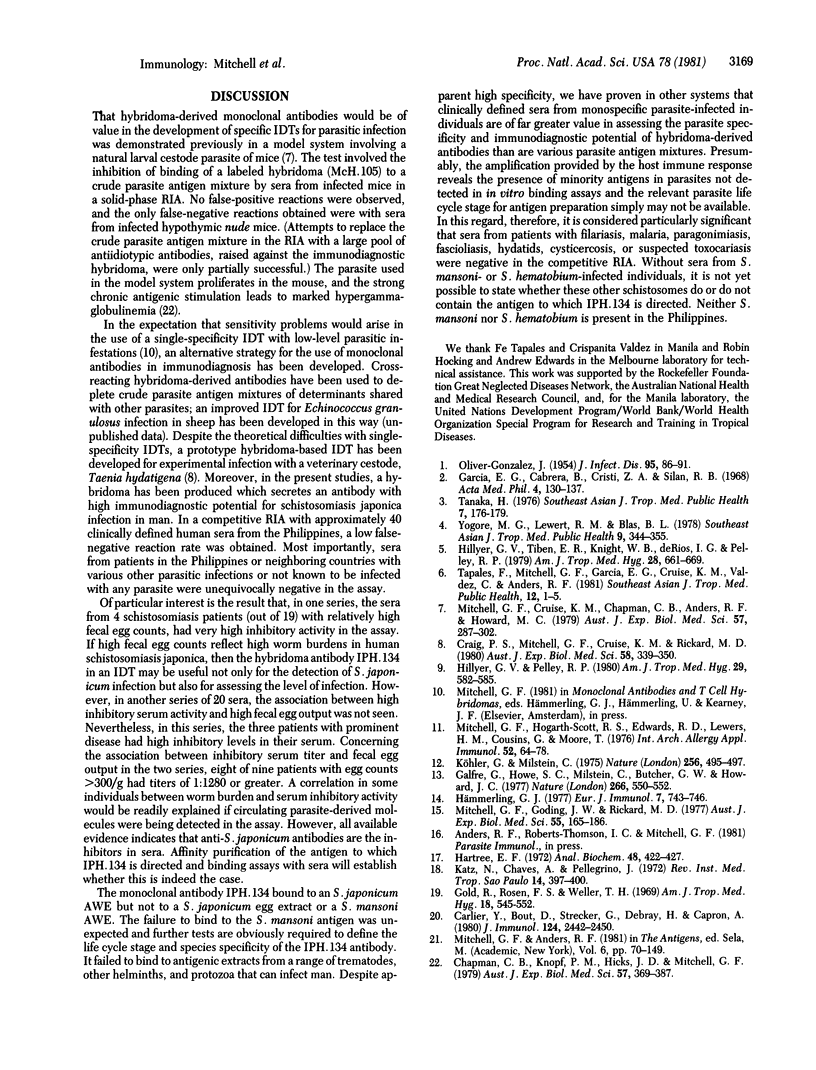
Images in this article
Selected References
These references are in PubMed. This may not be the complete list of references from this article.
- Carlier Y., Bout D., Strecker G., Debray H., Capron A. Purification, immunochemical, and biologic characterization of the Schistosoma circulating M antigen. J Immunol. 1980 May;124(5):2442–2450. [PubMed] [Google Scholar]
- Chapman C. B., Knopf P. M., Hicks J. D., Mitchell G. F. IgG1 hypergammaglobulinaemia in chronic parasitic infections in mice: magnitude of the response in mice infected with various parasites. Aust J Exp Biol Med Sci. 1979 Aug;57(4):369–387. doi: 10.1038/icb.1979.38. [DOI] [PubMed] [Google Scholar]
- Craig P. S., Mitchell G. F., Cruise K. M., Rickard M. D. Hybridoma antibody immunoassays for the detection of parasitic infection: attempts to produce an immunodiagnostic reagent for a larval taeniid cestode infection. Aust J Exp Biol Med Sci. 1980 Aug;58(4):339–350. doi: 10.1038/icb.1980.33. [DOI] [PubMed] [Google Scholar]
- Galfre G., Howe S. C., Milstein C., Butcher G. W., Howard J. C. Antibodies to major histocompatibility antigens produced by hybrid cell lines. Nature. 1977 Apr 7;266(5602):550–552. doi: 10.1038/266550a0. [DOI] [PubMed] [Google Scholar]
- Gold R., Rosen F. S., Weller T. H. A specific circulating antigen in hamsters infected with Schistosoma mansoni. Detection of antigen in serum and urine, and correlation between antigenic concentration and worm burden. Am J Trop Med Hyg. 1969 Jul;18(4):545–552. doi: 10.4269/ajtmh.1969.18.545. [DOI] [PubMed] [Google Scholar]
- Hartree E. F. Determination of protein: a modification of the Lowry method that gives a linear photometric response. Anal Biochem. 1972 Aug;48(2):422–427. doi: 10.1016/0003-2697(72)90094-2. [DOI] [PubMed] [Google Scholar]
- Hillyer G. V., Pelley R. P. The major serological antigen (MSA1) from Schistosoma mansoni eggs is a "circumoval" precipitinogen. Am J Trop Med Hyg. 1980 Jul;29(4):582–585. doi: 10.4269/ajtmh.1980.29.582. [DOI] [PubMed] [Google Scholar]
- Hillyer G. V., Ruiz Tiben E., Knight W. B., Gómez de Rios I., Pelley R. P. Immunodiagnosis of infection with Schistosoma mansoni: comparison of ELISA, radioimmunoassay, and precipitation tests performed with antigens from eggs. Am J Trop Med Hyg. 1979 Jul;28(4):661–669. [PubMed] [Google Scholar]
- Hämmerling G. J. T lymphocyte tissue culture lines produced by cell hybridization. Eur J Immunol. 1977 Oct;7(10):743–746. doi: 10.1002/eji.1830071018. [DOI] [PubMed] [Google Scholar]
- Katz N., Chaves A., Pellegrino J. A simple device for quantitative stool thick-smear technique in Schistosomiasis mansoni. Rev Inst Med Trop Sao Paulo. 1972 Nov-Dec;14(6):397–400. [PubMed] [Google Scholar]
- Köhler G., Milstein C. Continuous cultures of fused cells secreting antibody of predefined specificity. Nature. 1975 Aug 7;256(5517):495–497. doi: 10.1038/256495a0. [DOI] [PubMed] [Google Scholar]
- Mitchell G. F., Cruise K. M., Chapman C. B., Anders R. F., Howard M. C. Hybridoma antibody immunoassays for the detection of parasitic infection: development of a model system using a larval cestode infection in mice. Aust J Exp Biol Med Sci. 1979 Jun;57(3):287–302. doi: 10.1038/icb.1979.32. [DOI] [PubMed] [Google Scholar]
- Mitchell G. F., Goding J. W., Rickard M. D. Studies on immune responses to larval cestodes in mice. Increased susceptibility of certain mouse strains and hypothymic mice to Taenia taeniaeformis and analysis of passive transfer of resistance with serum. Aust J Exp Biol Med Sci. 1977 Apr;55(2):165–186. doi: 10.1038/icb.1977.13. [DOI] [PubMed] [Google Scholar]
- Mitchell G. F., Hogarth-Scott R. S., Edwards R. D., Lewers H. M., Cousins G., Moore T. Studies on immune responses to parasite antigens in mice. I. Ascaris suum larvae numbers and antiphosphorylcholine responses in infected mice of various strains and in hypothymic nu/nu mice. Int Arch Allergy Appl Immunol. 1976;52(1-4):64–78. doi: 10.1159/000231669. [DOI] [PubMed] [Google Scholar]
- OLIVER-GONZALEZ J. Anti-egg precipitins in the serum of humans infected with Schistosoma mansoni. J Infect Dis. 1954 Jul-Aug;95(1):86–91. doi: 10.1093/infdis/95.1.86. [DOI] [PubMed] [Google Scholar]
- Tanaka H. Complement fixation and circumoval precipitin reactions for diagnosis and as tests of core in schistosomiasis. Southeast Asian J Trop Med Public Health. 1976 Jun;7(2):176–179. [PubMed] [Google Scholar]
- Yogore M. G., Jr, Lewert R. M., Blas B. L. Schistosomiasis japonica in Barrio San Antonio, Basey, Samar in the Philippines: II. Quantitative fecal examination and circumoval precipitin tests. Southeast Asian J Trop Med Public Health. 1978 Sep;9(3):344–355. [PubMed] [Google Scholar]



